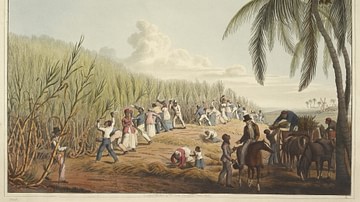Review

| Rating: | |
|---|---|
| Title: | The Problem of Immigration in a Slaveholding Republic: Policing Mobility in the Nineteenth-Century United States |
| Author: | Kevin Kenny |
| Audience: | University |
| Difficulty: | Hard |
| Publisher: | Oxford University Press |
| Published: | 2023 |
| Pages: | 344 |
Kevin Kenny’s "The Problem of Immigration in a Slaveholding Republic: Policing Mobility in the 19th Century United States" documents the legal history of the early United States through the late 1800s as the federal government rose to supremacy over the states in matters of immigration. While broad in its scope, Kenny's work should be a worthy addition to the collection of students interested in legal history and constitutional thinking.
In The Problem of Immigration, readers are introduced to a familiar historical struggle between the states and the federal government regarding matters of constitutional interpretation. Slave states in the antebellum period perceived a government overstepping its authority as it grew increasingly hostile to slavery. While Kevin Kenny presents the fear of the South losing control over slavery and the movement of free Black populations, he does so through the lens of several states’ police power over immigration.
The Supreme Court of 1837 sympathized with slavery. The new Chief Justice Roger Taney and several Associate Justices were either former slave owners or defenders of it. In the case of Miln v. New York (1837), Miln, a passenger aboard the Emily, challenged a law in the state that required the captain of the vessel to publish a report of passengers' names, ages, and last place of settlement Miln’s lawyers argued that New York’s law violated the U.S. Constitution's Commerce Clause. The state countered that it maintained sovereignty over commerce. Justice Philip Pendleton Barbour effectively sidestepped the issue with a 6-1 majority in arguing that New York’s law was a matter of internal policing "which is not granted to Congress." By focusing on policing, the court avoided constitutional issues regarding state authority and commerce thus avoiding issues of federal supremacy over the interstate slave trade.
While there is certainly a correlation at times between pro-slavery sentiments and anti-immigration ones, Kenny tries to have readers draw the connection that slavery and immigration have had their histories intertwined since the beginning. The book struggles at times to justify just how these two topics are always related. For instance, in the epilogue, Kenny brings the topic of immigration law and recent Supreme Court decisions to light. He mentions that the same reasoning of justices like the late Antonin Scalia in Arizona v. U.S. (2012) regarding states' police power over immigrants is found in the antebellum period. That is to say, whenever Scalia, or anyone else who invokes reasoning that may justify some restrictions on immigration does so, they find themselves in the company of slave owners and state rights advocates from the antebellum period.
Kenny can certainly focus on a recent history of immigration policy should he choose to, as the states and the federal government still find themselves at odds over the matter. Simply invoking the antebellum period at one's convenience for the issue today should not impress readers.
The most prominent period detailed is that of Chinese immigration. The Scott Act (1888) barred all Chinese workers who left the U.S. from returning, preventing entry to those who had previously been issued return certificates, and ending further issuances. Previously, the Chinese Exclusion Act (1882) had placed a ten-year ban on Chinese workers with some exceptions and allowed those workers who were forced to leave under the act to return if they obtained a certificate. Upon signing the Scott Act, President Grover Cleveland declared the period of Chinese workers coming to the US to be “in every sense unwise, impolitic, and injurious to both nations.”
Kenny uses concerns over an influx of Chinese labor and the passage of the aforesaid acts as the moment where the federal government established itself over the state immigration policy. Fear of Chinese immigration is presented for some as the threat of invasion with some Republican politicians against it as they saw Chinese workers as a new form of slavery. As Justice Stephen Field said in Chae Chan Ping v. United States (1889), exclusion was justified if Congress considered, “the presence of foreigners of a different race in this country, who will not assimilate with us, to be dangerous to its peace and security.”
Kenny, Glucksman Professor of History at New York University, shows how restricting immigration developed through the early years of independence and when the federal government came to steer immigration policy. While difficult at times to follow in that he does not focus his scope on one specific period and struggles to establish a clear line of thought that would justify his argument, The Problem of Immigration remains an impressive undertaking as a legal history.
The book is supplemented with a chronology from 1790 to 1898 in which legislation and Supreme Court decisions are noted with brief descriptions. Additionally, political cartoons and certificates of residence for Chinese workers provide imagery and source material.
About the Reviewer
Cite This Work
APA Style
Short, S. (2024, March 29). The Problem of Immigration in a Slaveholding Republic: Policing Mobility in the Nineteenth-Century United States. World History Encyclopedia. Retrieved from https://www.worldhistory.org/review/402/the-problem-of-immigration-in-a-slaveholding-repub/
Chicago Style
Short, Sam. "The Problem of Immigration in a Slaveholding Republic: Policing Mobility in the Nineteenth-Century United States." World History Encyclopedia. Last modified March 29, 2024. https://www.worldhistory.org/review/402/the-problem-of-immigration-in-a-slaveholding-repub/.
MLA Style
Short, Sam. "The Problem of Immigration in a Slaveholding Republic: Policing Mobility in the Nineteenth-Century United States." World History Encyclopedia. World History Encyclopedia, 29 Mar 2024. Web. 24 Oct 2024.




